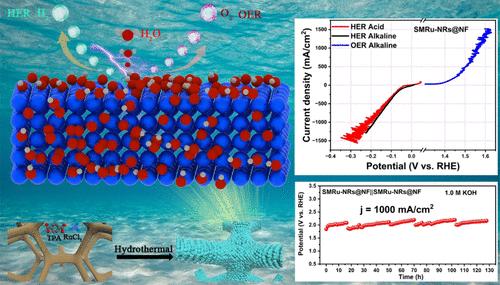当前位置:
X-MOL 学术
›
ACS Appl. Mater. Interfaces
›
论文详情
Our official English website, www.x-mol.net, welcomes your feedback! (Note: you will need to create a separate account there.)
Surface-Modified Ruthenium Nanorods for an Ampere-Level Bifunctional Hydrogen Evolution Reaction/Oxygen Evolution Reaction Electrocatalyst
ACS Applied Materials & Interfaces ( IF 8.3 ) Pub Date : 2024-06-28 , DOI: 10.1021/acsami.4c05286 Hong Tang 1, 2 , Takahiro Kojima 1, 2 , Kenji Kazumi 1, 2 , Kazuhiro Fukami 1, 2 , Hiroshi Sakaguchi 1, 2
ACS Applied Materials & Interfaces ( IF 8.3 ) Pub Date : 2024-06-28 , DOI: 10.1021/acsami.4c05286 Hong Tang 1, 2 , Takahiro Kojima 1, 2 , Kenji Kazumi 1, 2 , Kazuhiro Fukami 1, 2 , Hiroshi Sakaguchi 1, 2
Affiliation

|
The practical applications of bifunctional ruthenium-based electrocatalysts with two active sites of Ru nanoparticles covered with RuO2 skins are limited. One reason is the presence of multiple equally distributed facets, some of which are inactive. In contrast, ruthenium nanorods with a high aspect ratio have multiple unequally distributed facets containing the dominance of active faces for efficient electrocatalysis. However, the synthesis of ruthenium nanorods has not been achieved due to difficulties in controlling the growth. Additionally, it is known that the adsorption capacity of intermediates can be impacted by the surface of the catalyst. Inspired by these backgrounds, the surface-modified (SM) ruthenium nanorods having a dominant active facet of hcp (100) through chemisorbed oxygen and OH groups (SMRu-NRs@NF) are rationally synthesized through the surfactant coordination method. SMRu-NRs@NF exhibits excellent hydrogen evolution in acid and alkaline solutions with an ultralow overpotential of 215 and 185 mV reaching 1000 mA cm–2, respectively. Moreover, it has also shown brilliant oxygen evolution electrocatalysis in alkaline solution with a low potential of 1.58 V to reach 1000 mA cm–2. It also exhibits high durability over 143 h for the evolution of oxygen and hydrogen at 1000 mA cm–2. Density functional theory studies confirmed that surface modification of a ruthenium nanorod with chemisorbed oxygen and OH groups can optimize the reaction energy barriers of hydrogen and oxygen intermediates. The surface-modified ruthenium nanorod strategy paves a path to develop the practical water splitting electrocatalyst.
中文翻译:

用于安培级双功能析氢反应/析氧反应电催化剂的表面修饰钌纳米棒
具有两个RuO 2 皮覆盖的Ru纳米粒子活性位点的双功能钌基电催化剂的实际应用受到限制。原因之一是存在多个均匀分布的方面,其中一些是不活动的。相比之下,具有高纵横比的钌纳米棒具有多个不均匀分布的面,其中活性面占主导地位,可实现有效的电催化。然而,由于生长控制困难,钌纳米棒的合成尚未实现。此外,众所周知,中间体的吸附能力会受到催化剂表面的影响。受这些背景的启发,通过表面活性剂配位方法合理合成了通过化学吸附氧和OH基团以hcp(100)为主要活性面的表面修饰(SM)钌纳米棒(SMRu-NRs@NF)。 SMRu-NRs@NF 在酸性和碱性溶液中表现出优异的析氢能力,超低过电位分别为 215 mV 和 185 mV,达到 1000 mA cm –2 。此外,它还在碱性溶液中表现出出色的析氧电催化能力,在1.58 V的低电位下即可达到1000 mA cm –2 。它还对在 1000 mA cm –2 下析出氧气和氢气表现出超过 143 小时的高耐久性。密度泛函理论研究证实,用化学吸附的氧和OH基团对钌纳米棒进行表面修饰可以优化氢和氧中间体的反应能垒。表面改性钌纳米棒策略为开发实用的水分解电催化剂铺平了道路。
更新日期:2024-06-28
中文翻译:

用于安培级双功能析氢反应/析氧反应电催化剂的表面修饰钌纳米棒
具有两个RuO 2 皮覆盖的Ru纳米粒子活性位点的双功能钌基电催化剂的实际应用受到限制。原因之一是存在多个均匀分布的方面,其中一些是不活动的。相比之下,具有高纵横比的钌纳米棒具有多个不均匀分布的面,其中活性面占主导地位,可实现有效的电催化。然而,由于生长控制困难,钌纳米棒的合成尚未实现。此外,众所周知,中间体的吸附能力会受到催化剂表面的影响。受这些背景的启发,通过表面活性剂配位方法合理合成了通过化学吸附氧和OH基团以hcp(100)为主要活性面的表面修饰(SM)钌纳米棒(SMRu-NRs@NF)。 SMRu-NRs@NF 在酸性和碱性溶液中表现出优异的析氢能力,超低过电位分别为 215 mV 和 185 mV,达到 1000 mA cm –2 。此外,它还在碱性溶液中表现出出色的析氧电催化能力,在1.58 V的低电位下即可达到1000 mA cm –2 。它还对在 1000 mA cm –2 下析出氧气和氢气表现出超过 143 小时的高耐久性。密度泛函理论研究证实,用化学吸附的氧和OH基团对钌纳米棒进行表面修饰可以优化氢和氧中间体的反应能垒。表面改性钌纳米棒策略为开发实用的水分解电催化剂铺平了道路。











































 京公网安备 11010802027423号
京公网安备 11010802027423号